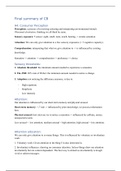Final summary of CB
H4: Consumer Perception
Perception: a process of reviewing selecting and interpreting environmental stimuli.
Phenomal absolutism: thinking we all think he same.
Sensory exposure: 5 senses: sight, smell, taste, touch, hearing -> creates sensation
Attention: We can only give attention to a few sensory exposures (+-7 cognitive capacity).
Comprehension: interpreting that what we give attention to -> is influenced by existing
knowledge.
Sensation -> attention -> comprehension -> preference -> choice.
Sensory thresholds:
1. Absolute threshold: the minimum amount needed to experience a sensation.
2. The JNB: 20% rule of Weber: the minimum amount needed to notice a change.
3. Adaption: not noticing the difference anymore, is due to:
- High repetition
- Simplicity
- Low intensity
Attention:
Our attention is influenced by our short-term memory and physical arousal.
Short-term memory: +-7 rule -> influenced by prior knowledge, we process information
here.
Physical arousal: how alert are we to notice a sensation -> influenced by caffeine, noises,
unexpected events.
Low arousal = low attention, medium arousal = high attention, high arousal = low attention.
Attention allocation:
We can only give attention to so many things. This is influenced by voluntary or involuntary
work:
1. Voluntary work: Given attention to the thing I’m also interested in.
2. Involuntary influences: drawing on consumer attention. Salient things draw our attention
involuntarily but are context dependent. The best way to stimuli us involuntarily is trough
vivid or salient messages:
,Salient stimuli (part of involuntary influence):
Something is salient when it stands out (Ferrari on the highway). This is context dependend,
salient things make other objects fade in to the background. Salience is created trought:
- Novelty: new and interesting, original, unexpected
- Intensity: size, length, loudness
- Complexity: they are intriguing and engaging
Vivid stimuli (part of involuntary influence):
Not dependent on context, but on the person. Draws our involuntary attention in every context
by:
- Emotional interest: our goals/hobbies/interests determine what we find appealing.
- Concrete imagery: flashing lights, bigger, louder, more colour, provoking. Face-to-
face can also increase concrete imagery
- Proximity to sensory: how did you experience it:
o Spatial: where you nearby?
o Temporal: how long was it ago?
o Sensory: did you see it yourself?
Grabbing attention can backfire if it distracts from the brand, product/service must be the
centre.
Attention can also be grabbed trough online targeting, surprise, shock, and celebrities if they
represented the wanted image.
Interpretation:
Understanding new information by relation it to information already stored in our memory.
We interpret based on what we already know. How we interpret things can be influenced by
visual tricks:
- Long things always feel larger than wide things
- 3D objects seem smaller
- Elongated things feel larger.
Size and shape influence our perception of something. We need to interpret before we can
comprehend something.
, H5: learning and memory:
Learning: proces of acquiring new information for future uses
Knowledge: connecting two concepts -> touching a hot stove burns.
Memory: enables us to use post experiences to influences current behaviour.
These three are important in search, evaluation and post-consumption.
We can learn in three ways:
1. Classical conditioning: learning by association, stimulus before message.
2. Evaluative conditioning: part of classical conditioning.
3. Operant conditioning: Stimulus follows message.
Classical conditioning: TT
Unconditioned stimulus creates an unconditioned response (food creates salivation). A
conditioned stimulus (brand) is paired with the unconditioned stimulus. After a while the
conditioned stimulus creates an unconditioned response, this is then called the conditioned
response.
Evaluative conditioning:
Influenced by classical conditioning but this extends to influence our attitude, instead of
behaviour. Creates longer lasting memory and it’s less susceptible to non-parring and can
better deal with multiple unconditioned stimulus paired to one conditioned stimulus.
The CS is a signal for US, the CS becomes positive independent of the US: the response is
now a feeling.
Inferential -> in evaluative conditioning we tend to infer more -> DHL & F1.
Forward conditioning: first the conditioned stimulus then the unconditioned response -> most
effective
Backward conditioning: reverse -> most used but needs more repetitions. Exemplar based
learning: seeing the US before the CS creates means I don’t think about what I think of brand.
I first see things that make me happy/hungry/etc. and then the brand. -> for low-involvement,
keeps us from thinking
Influences on conditioning:
- Pre-exposure effect: I’ve already heard things song, pairing it then to an ad does not
work as well
- Blocking: I know adidas makes good quality shoes, it’s hard for me to then remember
more things.
Operant conditioning:
Difference with classical conditioning -> stimulus follows the response, can be done in 3
ways, result is behavioural.
1. Positive reinforcement: thanks for buying here’s a present




